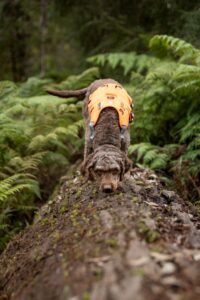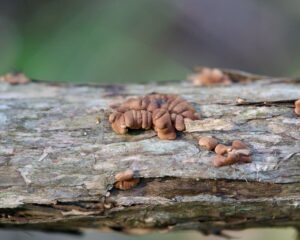
Detection dog sniffs out critically endangered fungus
It’s official, there’s a new Top Dog in conservation. After years of training, Zoos Victoria Detection Dog, Daisy, has used her incredible sense of smell to locate one of the rarest fungi in the world, tea-tree fingers. Daisy, a six-year-old Lagotto Romagnolo (Italian water dog), is a canine in Zoos Victoria’s Wildlife Detection Dog Squad – a team with a mission to help save Victoria’s threatened species.
Tea-tree fingers is a rare and elusive fungus that grows on dead tree branches. It is found within just a few known sites in dense tea-tree forest in Victoria, and only a few hundred individuals are known to scientists. Monitoring existing populations and locating further populations is vital for management of this Critically Endangered fungus.
Sporing bodies (the visible, reproducing part of the fungus) are small and brown, resembling decaying zombie-like digits, making them hard to detect for human surveyors. In a recently published article*, scientists from Zoos Victoria and Royal Botanic Gardens Victoria tested Daisy’s ability to detect tea-tree fingers, and compared her performance to their best human surveyor.
In her first field season, Daisy detected ten naturally occurring sporing bodies, four of which were missed by humans, and one was smaller than a grain of rice. During the experiment, Daisy found more sporing bodies than a human expert and took less time to do so. Combining pooch and human efforts has resulted in waggy tails and a model that can be used by other fungal conservationists world-wide.

Tea-tree fingers (Hypocreopsis amplectens) is categorised as Critically Endangered on the IUCN (International Union for Conservation of Nature) Red List of Threatened Species and is listed under the Victorian Flora and Fauna Guarantee Act. Threats to the fungus include climate change, habitat loss through sand mining and clearing, as well as bushfires. The detection dog field trials that led to the new discoveries were made possible thanks to the support of the Indianapolis Zoological Society, Parks Victoria, Trust for Nature and generous donors. Dr Nick Rutter, Zoos Victoria Wildlife Detection Dog Officer says, “The scent training is like trying to recognise a face in a pixelated photo.
Every new sample of fungus is like adding another pixel, which makes the scent picture clearer. After enough pixels are added, something clicks, and the scent picture of a new, wild fungus is recognised,” and “It’s a conservation win that Daisy can help to make the survey process quicker and easier. She has incredible attention to detail.” Dr Michael Amor, Royal Botanic Gardens Victoria says, “Tea-tree fingers is exceptionally picky and it can only exist in a particular habitat. This potentially makes it an indicator of a unique ecosystem that may have value to other species,” and “Tea-tree fingers is on the edge of extinction. We need to find and protect new individuals and populations. Ultimately, they can act as a bank of genetic diversity – the main currency of fitness and adaptability.”
Reference: https://www.cell.com/iscience/fulltext/S2589-0042(24)00951-9
